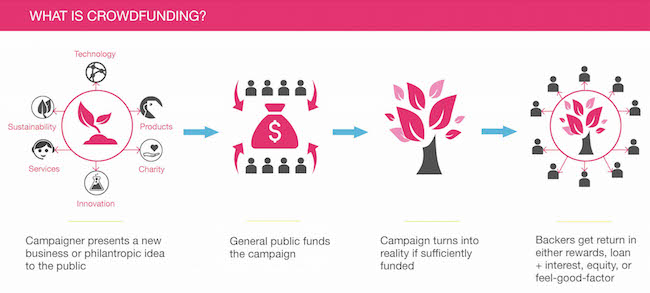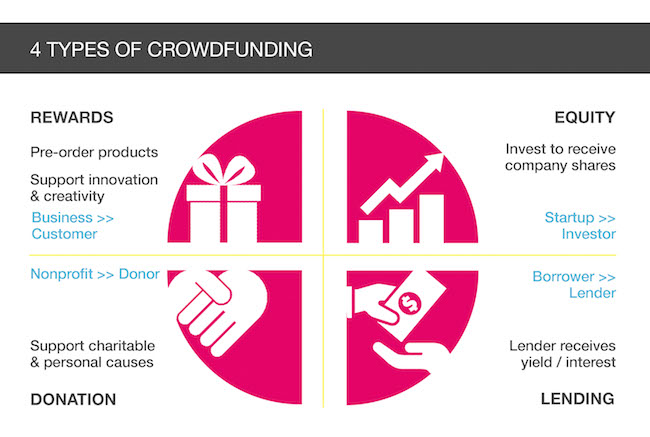FAQ for Potential Campaigners - Part 1

Are you interested in crowdfunding, but would like a clearer picture of what it involves? These FAQs will give you a comprehensive overview.
1. What is crowdfunding?
Crowdfunding, by definition, is “the practice of funding a project or venture by raising many small amounts of money from a large number of people, typically via the Internet.”
Instead of traditional investors, crowdfunding campaigns are funded by the general public. In particular by friends, family, extended networks or acquaintances.

2. What are the different types of crowdfunding?
There are four main types of crowdfunding:
Rewards-based: The most popular form of crowfunding, this format allows small businesses to communicate directly customers and offer them pre-sale opportunities for products, services, or creative projects.
Donations-based: Usually charities, NGOs, or the public would appeal to existing and potential donors to fund a charitable or personal cause or project.
Lending-based: Just like any other loan, this format allows the borrower to pay back lenders over time with interest.
Equity-based: Backers can invest in the company early on and receive shares to the company. This is generally limited to “accredited” investors, not the general public.
Not all countries support every type of crowdfunding service. Typically, rewards-based crowdfunding requires the least regulatory hurdle and is more widely accepted by the public. Equity crowdfunding laws in Asia are still lagging behind Europe and America.

3. What are the top crowdfunding platforms?
If you are thinking of crowdfunding, you need to consider which platform is best for your business or cause. The best-known platforms globally are Kickstarter and Indiegogo, with almost half the audience from the US, and the rest from UK, India, China, Japan and Korea, to name a few.
The rankings change often. Other platforms such as GoFundMe or RocketHub fall significantly behind the top 2. In Europe, Crowdcube and Funding Circle still dominate the space but several country or region specific platforms are gaining ground such as Symbid, KissKissBankBank and Ulule.
FlyingV in Taiwan claims to be the biggest platform in Asia, although they only offer Chinese language service. Singapore offers over 10 crowdfunding services. China also has its own star platforms such as DemoHour and AngelCrunch. Pozible, the leading crowdfunding site in Australia, boasts the highest success rate in the world. Many more budding platforms cater to geo-specific or industry-specific audience (like real estate or art).
4. What are the most successful cases of crowdfunding so far?
Globally, the most funded projects are mainly gaming, Internet of Things (IoT), and innovative products. Amongst the top campaigns, Travel Jacket, Beehive and Coolest Cooler are some of the most widely shared and talked about campaigns, especially on social media.
Here’s the link to all the top projects: https://en.wikipedia.org/wiki/List_of_highest_funded_crowdfunding_projects
5. Are there any other purposes of crowdfunding besides raising funds?
Although the main purpose of crowdfunding is to rally monetary support behind a project, there are other benefits:
Idea validation and feedback loop
One of the challenges of starting a business is that the idea does not get validated from target customers early on. Business or project owners tend to approach those who are already within their social circle and feedback become skewed or biased. Crowdfunding is a useful tool to validate a business idea with a wider network using social media.
Reaching likeminded individuals
Crowdfunding platforms can be utilized as marketing channels, motivating likeminded individuals to rally behind projects. It also helps the campaigner communicate the greater purpose behind their project and start building a loyal customer base.
Fine tune marketing messages
Having the fundraising campaign go on for multiple weeks allows the campaigner to tweak content and find the most compelling angle or message to engage the audience.
Enables continuous customer engagement
Crowdfunding is only one of the first stages in getting the brand or project noticed. Continuous engagement with backers after the project is key, especially as these are the people who were enticed by the story in the first place.
6. I have a business idea. Should I crowdfund?
There are three main concerns to think about before taking the plunge.
i. Determine whether your idea is solving a problem or serves a greater purpose. It’s not about what you do but WHY you do it. Communicating just the benefits of the product or service is not sufficient in motivating the audience to back projects. You need to be able to engage the audience in your story.
ii. Is your project scope and goal specific? Having a well-defined, narrower scope that caters to a smaller audience can garner more attention than throwing out an ambitious goal that tries to grab everyone’s attention. For example, if you are launching a new shoe brand, instead of trying to crowdfund for an entire shoe collection, pick a signature style and communicate how that product solves a specific problem.
iii. Many people also misunderstand the process thinking they do not need some form of initial investment in order to crowdfund. At the end of the day, it’s still a SELLING platform, and project creators need to factor in a cost for presenting their ideas, such as the video, enticing imagery, early supporters and some PR / marketing budget to be able to increase the chances of success.
Stay tuned for more information about crowdfunding implementation in Part 2 of this series.
Prepared by Nicole Denholder and Stephanie Poon, Founder of Zarie.co